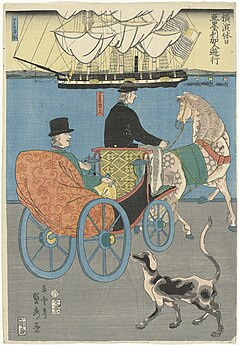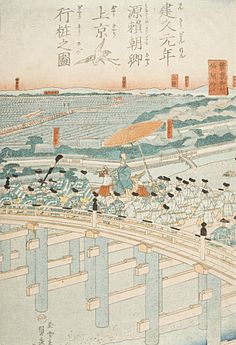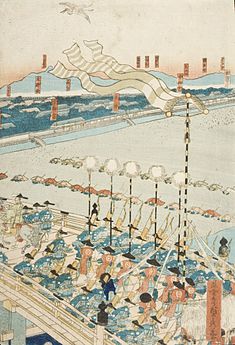
Utagawa Sadahide (歌川 貞秀, 1807 – c. 1878–1879), also known as Gountei Sadahide (五雲亭 貞秀), was a Japanese artist best known for his prints in the ukiyo-e style as a member of the Utagawa school. His prints covered a wide variety of genres; amongst his best known are his Yokohama-e pictures of foreigners in Yokohama in the 1860s, a period when he was a best-selling artist. He was a member of the Tokugawa shogunate's delegation to the International Exposition of 1867 in Paris.[1]
Life and career
Sadahide was born Hashimoto Kenjirō (橋本兼次郎)[2] in 1807 in Fusa Province (modern Chiba Prefecture) in Shimōsa.[3] He joined Utagawa school master Kunisada's studio in the 1820s and become one of the master's most prominent students.[1] As a member of the school, he took on Utagawa as a surname, and also used the surname Gountei as an art name, and also used his birth surname as an art name late in his career.[3] In addition, when Utagawa Kunisada succeeded to the art name of Utagawa Toyokuni , his students followed suit and changed "Sada (貞)" to "Kuni (国)", but Sadahide did not change his art name.[4]
Sadahide's earliest known works are the illustrations for a book Misaogata Tsuge no Ogushi (操形黄楊小櫛, 1824), the first of many books he was to illustrate throughout his career. In 1828 three years after the death of Utagawa Toyokuni, Utagawa Kunisada built a stone monument in Myokendo (妙見堂), on which the names of his students were inscribed, and Sadahide was the fourth name on the monument at the age of only 21.[5] Most of his early works were bijin-ga portraits of beauties. In the 1830s and 1840s he broadened his output to landscapes and musha-e warrior prints.[1] In particular, he excelled at painting bird's eye view of landscapes based on his research by actually walking around the land.[6]
In the 1850s Sadahide began to become known for his prints of exotic locales. In c. 1850 he produced the five-volume Kaigai Shinwa (海外新話, New Overseas Stories) about the First Opium War in China, and in 1855 he produced the four-volume Kita Ezo zusetsu (北蝦夷図説, Northern Japan Illustrated), which depicted the Ainu people in Ezo, the name at the time for the northernmost parts of Japan. This interest expanded to maps: he produces prints of maps of Edo, Yokohama, Japan, and the world[7]—this last quite accurate and likely modeled after a Dutch example.[2] His largest map was a nine-sheet panorama of Yokohama with a breadth of two metres.[7]
In the 1859 to 1862[2] Sadahide produced a large number of Yokohama-e prints of foreigners and the goods they brought to Japan after the country ended its self-imposed isolation in 1854. Among these prints was the series Edo meisho kenbutsu ijin, (江戸名所見物偉人, Foreigners Viewing Famous Places in Edo).[1] While there is scant evidence of the reception of these works, the number of extant copies suggests they were popular, and they appear to depict foreigners in a positive light. Several prints depict pleasant interactions between foreigner and Japanese figures, such as dining together or playing badminton. This in contrast to the philosophy of sonnō jōi ("revere the Emperor, expel the barbarians") that had gained currency since the Convention of Kanagawa of 1854.[8]
Sadahide also produced guidebooks to Yokohama, include one of five volumes in 1862–66 called Yokohama kaikō kenbun-shi (横浜開港見聞誌, Things seen and heard at the Yokohama open port). He details the eating habits and technology of Yokohama's foreign residents, and suggests the Japanese would do well to learn from the West with such statements as: "We are by nature emotional and want a quick profit, but nowadays the Japanese merchants in Yokohama are trying hard to follow the Western model of remaining calm." While these works emphasize contrasts between the Japanese and foreigners, they also dispel myths: Sadahide notes that not all foreigners are tall or have long noses, despite the stereotypes.[9]

The artist continued to make prints after moving to Nagasaki. There Sadahide made a panorama that was 10 metres (33 ft) long and produced books on the history and geography of Western lands.[2] He joined ten other artists as part of a delegation the Tokugawa shogunate sent to the International Exposition of 1867 in Paris,[1] where ten of his Edo views were exhibited.[2] The following year, it was reported he ranked the best-selling ukiyo-e artist. Sadahide died in 1878 or 1879,[1] shortly after producing a print of Yokohama the size of a tatami mat in 1871 entitled "Yokohama yokuran no shinkei".[1][11] The first exhibition dedicated to Sadahide's work was held in 1997, subtitled The ukiyo-e artist who flies in the sky (空飛ぶ浮世絵師 Sora tobu ukiyo-e-shi).[3]
His work is held in several museums worldwide, including the Fine Arts Museum of San Francisco,[12] the Minneapolis Institute of Art,[13] the Dallas Museum of Art,[14] the Five Colleges and Historic Deerfield Museum Consortium,[15] the Arizona State University Art Museum,[16] the Honolulu Museum of Art,[17] the Brooklyn Museum,[18] the British Museum,[19] the Philadelphia Museum of Art,[20] the Metropolitan Museum of Art,[21] the Van Gogh Museum,[22] the National Museum of New Zealand,[23] the Museum of Fine Arts, Boston,[24] the Victoria and Albert Museum,[25] the Saint Louis Art Museum,[26] the Indianapolis Museum of Art,[27] the University of Michigan Museum of Art,[28] the Suntory Museum of Art,[29] the Carnegie Museum of Art,[30] the Harvard Art Museums,[31] and the National Museum of Korea.[32]
- Prints by Utagawa Sadahide
-
American on an Outing, 1861
-
Chinese Men in Yokohama, c. 1860
-
Lord Yoritomo Traveling to Kyoto (1), 1862
-
Lord Yoritomo Traveling to Kyoto (2), 1862
-
Lord Yoritomo Traveling to Kyoto (3), 1862
References
- ^ a b c d e f g Marks 2012, p. 144.
- ^ a b c d e Meech 1986, p. 40.
- ^ a b c Kanbara 2006, p. 148.
- ^ Umemoto 1898, p. 106.
- ^ Fujikake 1946, pp. 255–256.
- ^ Inoue 1931, p. 75.
- ^ a b Steele 2003, p. 22.
- ^ Steele 2003, pp. 22–23.
- ^ Steele 2003, p. 24.
- ^ "横浜弌覧之真景 / 橋本玉蘭斎 図画". www.wul.waseda.ac.jp. Retrieved 2017-11-20.
- ^ "Yokohama yokuran no shinkei / Hashimoto Gyokuransai zukaku ; Ōizumi Kanegorō chōkō". UM Clark Library Maps. Retrieved 2017-11-20.
- ^ "Group 1, No. I. Nihonbashi - Utagawa Kunisada, Utagawa Hiroshige II, Kunisada II, Utagawa Sadahide". FAMSF Search the Collections. 2017-09-20. Retrieved 2021-01-07.
- ^ "Pictured Phenomenon vol. 4, Utagawa Sadahide ^ Minneapolis Institute of Art". collections.artsmia.org. Retrieved 2021-01-07.
- ^ "Kanadehon Chushingura: Act VII - DMA Collection Online". www.dma.org. Retrieved 2021-01-07.
- ^ "Collections Database". museums.fivecolleges.edu. Retrieved 2021-01-07.
- ^ Yokokawa Hori Iwa; 横川 彫 岩; Yamaguchiya Tōbei; 山口屋 藤兵衛 (1861), The View from Atago Hill, hdl:2286/R.I.43199, retrieved 2021-01-07
- ^ "Chiryū, from the series Tōkaidō Album by various artists (Suehiro Gojūsantsugi Zue), from the series Tōkaidō Album by various artists | Honolulu Museum of Art". honolulumuseum.org. Retrieved 2021-01-07.
- ^ "Brooklyn Museum". www.brooklynmuseum.org. Retrieved 2021-01-07.
- ^ "illustrated book; print | British Museum". The British Museum. Retrieved 2021-01-07.
- ^ "Philadelphia Museum of Art - Collections : Search Collections". www.philamuseum.org. Retrieved 2021-01-07.
- ^ "Foreigners in the Drawing Room of Foreign Merchant's House in Yokohama 9th month, 1861". www.metmuseum.org. Retrieved 2021-01-07.
- ^ "Illustration of Making Cocoons into Silk Floss, no.9, and no. 10, Illustration of Threading the Loom and Starting the Weaving - Van Gogh Museum". vangoghmuseum-prod.azurewebsites.net. Retrieved 2021-01-07.
- ^ "Collections Online - Museum of New Zealand Te Papa Tongarewa". collections.tepapa.govt.nz. Retrieved 2021-01-07.
- ^ "Vengeance at Ganryûjima (Ganryûjima katakiuchi no zu)". collections.mfa.org. Retrieved 2021-01-07.
- ^ "Woodblock print | Utagawa Sadahide | V&A Search the Collections". V and A Collections. 2021-01-07. Retrieved 2021-01-07.
- ^ "Picture of a Salesroom in a Foreign Mercantile Firm in Yokohama". Saint Louis Art Museum. Retrieved 2021-01-07.
- ^ "Portrait of God of Silkworm Production in Greater Japan and Brief Biography". Indianapolis Museum of Art Online Collection. Retrieved 2021-01-07.
- ^ "Exchange: Scene at Hachiman Hill". exchange.umma.umich.edu. Retrieved 2021-01-07.
- ^ "Collection Database". SUNTORY MUSEUM of ART. Retrieved 2021-01-07.
- ^ "CMOA Collection". collection.cmoa.org. Retrieved 2021-01-07.
- ^ Harvard. "From the Harvard Art Museums' collections Procession". harvardartmuseums.org. Retrieved 2021-01-07.
- ^ "Print of Freight Transportation in Yokohama by Utagawa Sadahide".
Works cited
- Kanbara, Mayumi (2006). "Gountei Sadahide". In Kobayashi, Tadashi (ed.). Ukiyo eshi retsuden 浮世絵師列伝. Bessatsu Taiyō (in Japanese). Heibonsha. pp. 148–149. ISBN 9784582944938.
- Marks, Andreas (2012). Japanese Woodblock Prints: Artists, Publishers and Masterworks: 1680–1900. Tuttle Publishing. ISBN 978-1-4629-0599-7.
- Meech, Julia (1986). The World of the Meiji Print: Impressions of a New Civilization. Weatherhill. ISBN 978-0-8348-0209-4.
- Steele, M. William (2003). Alternative Narratives in Modern Japanese History. Routledge. ISBN 978-1-134-40408-7.
- Fujikake, Shinya (1946). Ukiyo e 浮世絵. Yuzankaku.
- Umemoto, Syotaro (1898). Ukiyo e biko 浮世絵備考. Toyodo.
- Inoue, Kazuo (1931). Ukiyo eshi den 浮世絵師伝. Watanabehangaten.
External links
 Media related to Utagawa Sadahide at Wikimedia Commons
Media related to Utagawa Sadahide at Wikimedia Commons- Sadahide prints at ukiyo-e.org













